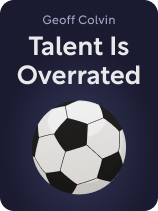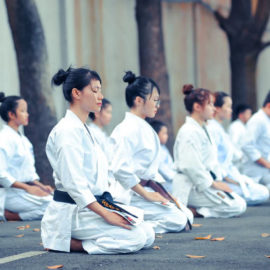

This article is an excerpt from the Shortform book guide to "Talent Is Overrated" by Geoff Colvin. Shortform has the world's best summaries and analyses of books you should be reading.
Like this article? Sign up for a free trial here.
Is talent overrated? What does it take to become good at something?
In Talent Is Overrated, Geoff Colvin explains why practice has a much bigger impact on performance than talent. Evidence suggests that time spent practicing is the number one indicator of excellence.
Learn what it takes to get better at something and meet your goals.
About Talent Is Overrated
In Talent Is Overrated, Geoff Colvin explores the origins of excellent performance—how some people can perform at a globally impressive level while the average person falls far short. Most people attribute this excellent performance to talent: a high level of ability in a specific area that’s inherent (rather than developed) and usually appears at an early age. This belief is attractive because an unusual, inborn trait seems to explain why excellence is rarely achieved and why it sometimes seems inheritable—why an excellent athlete’s child is more likely to excel in athletics than other children, for example.
However, Colvin rejects talent as the cause of excellence. He argues that this belief in talent isn’t supported by evidence (which we’ll discuss in the next section). In addition, he says believing in talent can stop people from becoming excellent: If you believe excellence is dictated by intrinsic talent, rather than something you can control, you won’t make any effort and thus won’t become an excellent performer. In contrast, If you believe you can become excellent, you’re more likely to put in the work necessary to succeed.
(Shortform note: Colvin’s ideas mirror the concept of fixed vs. growth mindsets. People with fixed mindsets believe their abilities can’t improve. They often refuse to challenge themselves out of a fear of failure, and they often have low self-esteem because they attribute failure to who they are as a person. In contrast, people with a growth mindset believe they can improve. They readily face challenges because they attribute failure to their performance, not their identity, so they’re motivated to improve and succeed. To nurture a growth mindset, remember that our brains develop throughout our lives. So, scientifically, there’s no reason you can’t improve.)
Colvin is a business journalist and speaker, as well as the senior editor-at-large for Fortune magazine. He first wrote about talent vs. training in an article for Fortune. The article had such a positive effect on readers that Colvin decided to explore the topic in more depth by writing Talent Is Overrated. This is Colvin’s second book about success in business. Since publishing it in 2008, he’s written two more.
In this article, we’ll explore why Colvin rejects talent as the cause of excellent performance and how shifting your mindset from talent to training can help you excel. Then, we’ll discuss Colvin’s definition of practice, how it works, and how you can implement it in your life. In our commentary, we’ll look at the psychology behind some of Colvin’s ideas. We’ll also compare his ideas with those of other experts, like Malcolm Gladwell, and with the experience of excellent performers, like former Olympian Matthew Syed.
Talent Doesn’t Adequately Explain Excellent Performance
While excellent performance is popularly attributed to talent, Colvin says there’s little empirical evidence that talent even exists, let alone that it’s the determining factor in excellent performance. In fact, the lives of excellent performers tend to contradict the notions that talent is inherent and appears early in life. Even in artistic fields (in which many people believe talent is a major factor), research shows that most excellent performers don’t start being excellent until after they begin formal training. If they displayed excellent performance at an unusually young age, it was because their parents encouraged their abilities—or even began their formal training—from an early age.
What Is Deliberate Practice?
Colvin says deliberate practice involves continually identifying the weak points of your performance and working to improve them. As you strengthen each weak point, your overall performance improves.
Everyone deliberately practices when first learning a new activity, Colvin adds. However, most people stop doing so once they can comfortably perform the activity. It’s easier to let instinct and muscle memory take over, so they stop actively correcting their weak points and their performance stops improving. In contrast, excellent performers continue deliberately practicing until their performance improves far above average.
Take swimming, for example. When you first learned how to swim, you consciously practiced it: You had to actively think about how the different strokes worked and whether you were moving your limbs correctly. Now that you’re comfortable swimming, though, you don’t think about it as much. You already know how to do the strokes, and you can largely rely on muscle memory to execute them. You’re not the fastest or the most graceful, but you can have fun in the pool, so you don’t worry about perfecting your technique. Thus, you remain a decent but unremarkable swimmer. Olympic swimmers, on the other hand, devote their lives to perfecting their technique. They constantly monitor and improve their every movement, and this focus lets them excel.
How Deliberate Practice Improves Performance
If talent can’t explain excellent performance, how can deliberate practice do so? Colvin says that deliberate practice improves your performance in a specific field by helping you understand how that field works as a whole. Instead of believing that your understanding and skill are dictated by an inherent talent, you build your understanding and skill by analyzing and tracking your performance. As you analyze your mistakes and experiment with methods of fixing them, you begin to recognize commonalities between your mistakes or successes. These commonalities reveal the overarching rules that govern your field. You can then follow these rules to avoid future mistakes and improve your performance, growing closer to excellence.
How Long Deliberate Practice Takes
Deliberate practice can improve your performance almost immediately, as any amount of practice increases your understanding and thus equips you to perform better. Therefore, Colvin encourages people of every age and experience level to deliberately practice. Even if you don’t have time to become excellent, you can become better.
If you want to achieve world-class excellence, however, deliberate practice requires a massive time commitment, writes Colvin. On average, it takes 10 years of continual deliberate practice for a person to improve their understanding and skill enough to perform excellently. As discussed previously, Colvin says the inability or unwillingness to make this commitment is one of the reasons so few people achieve excellence.
How to Deliberately Practice
Now that we’ve covered what deliberate practice is and how it improves your performance, we’ll discuss how you can deliberately practice. Colvin says there are two main approaches: direct practice and indirect practice (or practicing in the work, as he calls it). Both approaches follow the same general process: Identify a weak point, create a plan to improve that weak point, analyze your performance to see whether your improvement plan worked, and adjust your improvement plan before repeating. However, the situations in which you use the approaches differ, as do the specific methods used in each step of the process.
Direct Practice
Direct practice involves practicing a skill in an engineered situation. Colvin suggests that this approach is especially helpful when the situation you want to use the skill in doesn’t occur often enough for you to adequately practice. Thus, it’s useful for improving skills you don’t use in your daily life. Our swimming example is a form of direct practice: If you want to swim faster to win competitions (the desired situation), you must practice outside of competitions, too, as they don’t happen often enough for you to improve your skills solely while competing.
Indirect Practice
Indirect practice involves practicing a skill within the situation where you want to use it. Colvin describes this approach as being mostly used for tasks you perform frequently. Thus, this approach is useful for improving skills you use in daily life, like those related to your career.
Since you’re already in a situation that lets you practice the skill, you don’t need to design an exercise. Instead, you choose a weak point related to the task you’re completing and practice it while completing the task. For instance, say you’re a manager and one of your tasks is giving feedback to your team members. You’re in the desired situation (feedback meetings) once a week, so you can practice while completing that task instead of practicing outside work.
Step #1: Identify the Weak Point You Want to Improve
First, identify a specific weak point to focus on, Colvin says. You can’t work on more than one weak point at a time because it would be difficult to track your technique and progress properly. If you’re moving erratically between weak points and techniques, you can’t be certain which of them actually improved your performance—thus, you can’t replicate that improvement or move on to solving the next issue. In contrast, devoting your energy and time to excelling at one aspect of your field lets you accurately identify which techniques improve your performance and correct weak points in a steady, consistent way.
To choose a weak point, first choose a task you need to complete. Then, determine which skills help you complete that task. Finally, identify which of those skills needs the most improvement—which skill you’re worst at. Returning to our manager example, the skills that help you give feedback to your team members are active listening and clear communication. If you’re already an active listener but you struggle to articulate your thoughts, you most need to develop clarity. Thus, you decide to focus on improving that weak point.
Step #2: Create an Improvement Plan
Once you’ve chosen a weak point, you must create a plan for how you’ll improve that weak point while completing your task. This helps you commit: You know exactly what you need to do, so you can focus on performing the skill to the best of your ability.
To create this plan, says Colvin, consider the process you usually use when completing your task. Then, set a specific goal for what you’ll do differently to practice your chosen skill. For example, your normal process for giving feedback might be to briefly outline all your feedback and then ask your subordinate if they have any questions. You only go into more detail about the points they ask questions about. Instead, you might decide to practice clarity by discussing each point in more detail from the beginning. Specifically, you decide to devote at least five minutes to discussing each feedback point and to include an example of each in your discussion (if you praise their leadership, you’ll share an example of a time they were a strong leader).
Step #3: Analyze Your Performance
Next, analyze your performance. Analyzing how well you completed your task gives you the feedback needed to adjust your process and become more successful in the future. One way to do this is to compare your performance to someone who’s slightly better at your chosen skill. This pushes you to improve without setting the standard so high that it’s impossible to reach and becomes discouraging. Then, walk back through your plan and identify ways your performance falls short of that standard and how you can avoid that in the future.
Step #4: Adjust Your Improvement Plan and Repeat
Finally, adjust your improvement plan with the feedback you gained in Step #3 and then repeat it. This step turns your deliberate practice into a virtuous cycle, allowing you to continue gathering more information and gradually improving your performance.
Exercise: Deliberately Practice
According to Colvin, deliberate practice involves continually identifying the weak points of your performance and working to improve them. In this exercise, you’ll follow the indirect approach to select a weak point you want to address, create a practice exercise, and identify the best way to improve your performance.
- First, identify your most important task. What skills help you complete it? Which of these skills are you worst at? For example, if your task is to give feedback to your subordinates, you may choose to work on clear communication.
- Now, write down the process you usually use to complete your important task. For example, your normal process for giving feedback might be to briefly outline all your feedback and then ask your subordinate if they have any questions.
- Then, make a plan for how you’ll practice your chosen skill more the next time you complete that task. For example, you might practice clarity by devoting at least five minutes to discussing each feedback point and including an example of each in your discussion.
- Next, compare your performance to someone who’s slightly better at that skill than you are. Walk back through your plan and identify ways your performance falls short of that standard and how you can avoid that in the future. For example, if your manager is a clear communicator, you may compare how they provide feedback to your own method. You realize that your manager spends 10 minutes discussing each feedback point, instead of five.
- Finally, use the information you learned in the previous step to adjust your technique. For example, you may increase the time you spend discussing each feedback point to at least 10 minutes.

———End of Preview———
Like what you just read? Read the rest of the world's best book summary and analysis of Geoff Colvin's "Talent Is Overrated" at Shortform.
Here's what you'll find in our full Talent Is Overrated summary:
- How some people can perform at a globally impressive level while the average person can't
- Why you need to shift your mindset from talent to training
- How to use the two approaches to deliberate practice successfully






